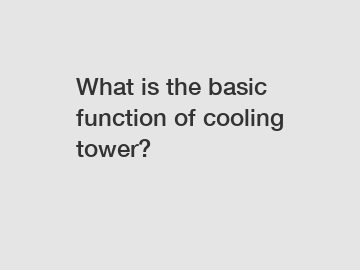What is the basic function of cooling tower?
As industries around the world continue to evolve and advance, the efficient management of heat generated during various processes has become more crucial than ever. Cooling towers, a ubiquitous piece of equipment in industrial settings, play a significant role in maintaining optimal temperatures and protecting machinery. In this blog, we will delve into the basic function of cooling towers, exploring their invaluable advantages and the vital role they play in industrial cooling systems.
Understanding Cooling Towers:
Cooling towers are heat rejection devices that facilitate the process of removing excess heat from a system to maintain an ideal temperature range. They find application in diverse industries, including power plants, refineries, petrochemical plants, HVAC systems, and many more. Let's dive deeper into the basic workings of these fascinating structures.

The Cooling Process:
The primary function of a cooling tower is to facilitate the transfer of heat from a warm fluid stream to the atmosphere, using either direct or indirect methods. Let's explore both processes.
1. Direct Heat Transfer:
In this process, hot water from an industrial process is pumped into the cooling tower, where it is spread over a fill material. As the warm water descends, air, often generated by large fans, passes through the fill, allowing the heat to transfer from the water to the air via evaporation. This exchange cools the water and creates a continuously cooled stream that can then circulate back into the industrial process.
2. Indirect Heat Exchange:
Certain applications require additional measures to cool fluids, such as oils, chemicals, or gases. In these cases, cooling towers employ the principle of indirect heat exchange. Here, a closed-loop system circulates the hot fluid through a heat exchanger, creating a separate interface with the cooling tower water. This ensures that the cooling tower water, which is in contact with the atmosphere, never comes into direct contact with the hot fluid.
The Role of Cooling Tower Components:
Cooling towers consist of several key components that work together harmoniously to facilitate efficient heat dissipation. Let's look at the main elements of these towers:
1. Fill Media:
The fill media forms an integral part of cooling towers, promoting maximum contact between the circulating water and the cooling air. These media can be structured as fill sheets, grids, or packs, creating extensive surface areas that enable efficient heat transfer.
Additional resources:What is the ideal temperature for tomatoes?
Steam-Filled Showers vs. Saunas: The Ultimate Relaxation Battle
How Does Cyclone Dust Collector Work?
The Advantages of Cooling Towers for Commercial Buildings
The 8 Best Outdoor Furniture Covers of 2024, According to ...
How to get a pacifier for free?
Maximize Livestock Nutrition with Hydroponic Fodder Systems
2. Fans:
Large fans are crucial in cooling towers to provide the necessary airflow to facilitate heat exchange. These fans drive air through the fill media, expediting the evaporation process and enhancing the cooling efficiency.
3. Water Distribution System:
An equally important component, the water distribution system, ensures that the hot water adequately covers the fill media, optimizing its contact with the cooling air. Spray nozzles evenly disperse the water over the fill material, allowing for efficient heat transfer.
Enhanced Cooling Tower Capabilities:
While the basic function of a cooling tower revolves around heat dissipation, modern technologies and advancements have allowed for further enhancements and improved performance. Some notable techniques employed to optimize cooling tower efficiency include:
1. Variable Frequency Drives (VFD):
By incorporating VFD technology, cooling towers can precisely control the speed of the fan motors, allowing for energy savings and better regulation of the cooling process.
2. Water Treatment:
To prevent scaling, corrosion, and biological growth, cooling towers often incorporate sophisticated water treatment systems. These systems ensure the longevity and reliability of the tower while maintaining water quality.
Conclusion:
Cooling towers have become an indispensable component of industrial cooling systems across various sectors. Their primary function of managing heat dissipation has been refined over the years, and they continue to evolve with advanced technologies. By efficiently transferring heat from industrial processes to the atmosphere, cooling towers support the safe and reliable operation of critical machinery.+.
For more crossflow vs counterflow, the air sponge filter company, fill cooling towerinformation, please contact us. We will provide professional answers.
Additional resources:10 Questions You Should Know about Elevator Plate
How to Choose a High House Greenhouse
How does the Lost foam casting process work?
What Are the Advantages of vae powder manufacturer?
Lost Foam Casting: Stages, Advantages, and Disadvantages
Good Price Cooling Tower Motor for Sale - AOSHUAI
How Does mulching tomato plants Work?

Comments
0